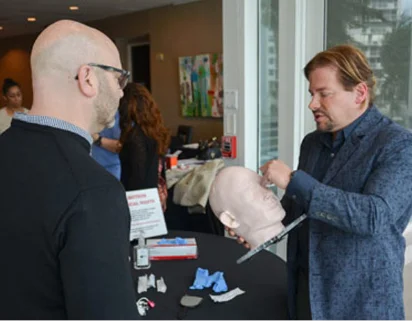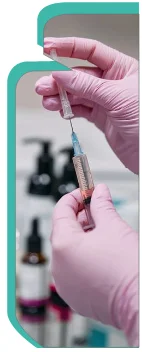Who Can Administer Botox®? Find Qualified Professionals
By Dr. Stephen Cosentino
PRESIDENT OF EMPIRE MEDICAL TRAINING
Neurotoxins | March 3, 2021

Who Can Administer
Botox®
Entry made by
Empire Medical Training
Botox® is an injectable medication derived from a neurotoxin produced by a large, rod-shaped bacterium known as Clostridium botulinum. This neurotoxin is among the deadliest substances known to occur in nature, yet Botox supports
thousands of thriving aesthetic practices and features in some of the world’s most popular cosmetic treatments.
Botox’s popularity is a testament to decades of scientific inquiry that tamed C. botulinum (greatly reducing
the incidence of “wild” botulinum poisoning, known as botulism) and produced a safe medication with a wide range of official indications and off-label uses and low incidence of serious side effects.
It is also a testament
to the relative ease of storing and administering the medication itself. While Botox can be administered only by licensed medical professionals, usually acting under a plastic surgeon’s or other physician’s supervision, Botox
procedures do not require special licensing or extensive training. Professionals permitted to administer Botox under state law can complete the necessary continuing medical education prerequisites and Botox certification coursework in a matter of days.
This is not to say that anyone with medical training is suited (or permitted, legally speaking) to administer Botox. This guide answers the
question on everyone’s mind — who can administer Botox? — and covers:
- The types of medical professionals most likely to administer Botox
- The prerequisites and training needed to safely administer Botox General guidelines for administering Botox in clinical settings
- The prerequisites and training needed to safely administer Botox General guidelines for administering Botox in clinical settings
What to Expect From This Guide on How to Inject Botox
- How Botox is injected
- Technical specifications for the medication and general injection procedures
- How Botox works on human nerves and muscles
- How to evaluate treatment candidates and spot contraindications before injection
- Monitoring Botox injection sites and patients for possible side effects and complications
Who Typically Performs Botox Procedures?
As a controlled substance, Botox is not available for legal purchase outside of official pharmaceutical supply chains. Patients and unlicensed professionals cannot purchase Botox for their own use or for commercial procedures not performed under the supervision of a licensed physician. Botox can be purchased and stored for end-use only by licensed medical professionals cleared by regulatory authorities to do so — most often physicians (medical doctors, doctors of osteopathy, and podiatrists) and dentists. So-called “Botox parties” are not legal anywhere in the United States
Who Can Inject Botox?
Botox can be injected by a wider range of licensed medical professionals acting under physician supervision, subject to applicable state law. Professionals who may be permitted to administer Botox include:
- Licensed physicians and surgeons
- Dentists
- Nurse practitioners
- Physician assistants
- Registered nurses and certain other types of nurses
- Medical assistants
- Clinical assistants
- Phlebotomists
- Aestheticians
- Paramedics
- Physical therapists
- Specialized medical therapists (such as respiratory therapists)
- Discussing the procedure with the patient prior to treatment and answering their questions
- Providing the patient with information about possible side effects and complications after the injection treatments as well as instructions to increase their comfort and ensure their safety in the hours and days after the procedure
- Preparing the injection sites, usually with alcohol-free cleaning pads
- Applying a topical anesthetic to the injection site, if needed
- Stabilizing the injection sites following the procedure (for example, by applying pressure to stop bleeding)
- Applying moisturizer or sun protection after the procedure

Geographical Considerations
Although federal regulators (most importantly, the U.S. Food and Drug Administration) approve the use of Botox to treat specific medical issues (indications), state
laws govern the actual administration of Botox.
What a state requires may vary. This makes it vitally important that clinicians aspiring to add Botox treatment to their practice roster understand and abide by the laws
governing their jurisdictions. Failure to do so could result in fines, regulatory action, and even criminal penalties.
The best sources of information about state laws related to Botox administration are state health
regulators themselves. But the most relevant state-by-state legal variations concern the identities of those permitted to administer Botox and their supervisors, along with the extent of the training and certification they
are required to complete before working with Botox patients. For example:
- In California, only licensed physicians may inject Botox without supervision by another professional. Registered nurses (including nurse practitioners) and physician assistants may inject Botox under the supervision or direction of a licensed physician.
- Illinois state law explicitly prohibits aestheticians from performing Botox procedures while allowing “licensed medical professionals” to inject Botox.
- New York state law also allows “licensed medical professionals,” including registered nurses, to inject Botox under the supervision of a physician, dentist, physician assistant, or nurse practitioner. PAs and NPs delegating Botox injection authority may need to work under the supervision of a physician, however.
- Dentists may be permitted to perform Botox procedures only as part of an approved dental treatment plan
- Dentists may not be permitted to work with Botox Cosmetic, the formulation marked for cosmetic use (such as correcting facial wrinkles and lines)
- Dentists may be limited to certain specific Botox indications, such as TMJ
Prerequisites and Training Required to Administer Botox
State regulations also govern Botox course and certification requirements. However, these requirements tend to be straightforward and do not require extensive coursework; there is no such thing as a “Botox degree.” In most cases, professionals can administer
Botox legally after completing a one- or two-day continuing medical education (CME) course and passing a written examination.
Accredited Botox classes include a mix of classroom
instruction and hands-on work. Specific topics covered during these sessions can include:
- An overview of Botox and other botulinum toxin products ( Botox competitors)
- An overview of FDA-approved Botox treatment procedures and the underlying conditions associated with them
- An overview of facial anatomy, a key prerequisite for many cosmetic injectables
- General best practices for safe Botox administration
- Procedure-specific guidance for Botox use
- Procedure demonstrations (such as injection techniques) by licensed Botox clinicians
- Hands-on instruction that may include opportunities for students to perform Botox procedures on volunteers
A Note About Non-Accredited Botox Courses
Clinicians should take care to use only accredited Botox course providers. Coursework offered by non-accredited providers may not meet minimum state regulatory standards and may result in clinicians operating outside the confines of the law. Likewise, non-comprehensive Botox courses may omit important information and result in clinicians offering substandard, potentially unsafe care.


